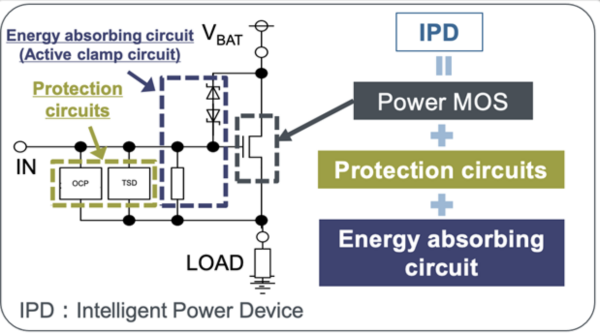Intelligent power devices provide increased protection and performance.
What is an intelligent power device?
Power MOSFET switches are used in myriad systems with applications spanning consumer, industrial, and automotive spaces. These circuits perform functions like PWM dimming of light-emitting diodes (LEDs), display backlight drivers, headlight switches, and high voltage relay controllers. In all of these examples, the power MOSFET must be protected from overcurrent and overvoltage conditions to prevent catastrophic and potentially unsafe failure conditions.
Intelligent Power Devices (IPDs) integrate the power MOSFET switch, along with all of these discrete protections, into a single chip. This provides a lower cost solution along with enhanced protection performance against overheating, overvoltage, overcurrent, and load short circuiting.
Owing to ROHM’s state-of-the-art IC fabrication capabilities and vertical manufacturing process, low On resistance vertical MOS switches can be built on the same die as the CMOS protection devices. This includes the overcurrent sensor, temperature sensors, and—in some cases—logic level flags for microcontroller monitoring.
The IPD advantage
Traditional power switches are protected by a series of discrete sensors for current, temperature, and the like, along with either a fuse or mechanical relay to disengage the switch and prevent catastrophic failure. Fuses are problematic in real world applications because they require replacement and must be carefully chosen for proper overcurrent timing requirements. The combination of in-rush current and standard operating current can result in a fuse trip current profile that leaves a significant margin of unprotected operation. An IPD, in comparison, has an ideal L-shape protection curve that offers a very tight current envelope and does not require replacement after activation.
Another protection option often employed in traditional power switch designs is the mechanical relay. Unlike fuses, relays need not be replaced and can turn on and off reliably under a wide range of current and timing requirements. Unfortunately, relays do suffer from mechanical wear out over time and have a limited operating life. In addition, the mechanical action of relays exhibits noticeable acoustic noise that can be unacceptable in many designs. In contrast to the way in which a mechanical relay wears out over time, a semiconductor IPD suffers no such deterioration, even under large loads.
IPDs outperform fuses, relays, and discrete semiconductor solutions in reliability, design flexibility, and ease of use. Owing to the collocation of CMOS circuitry with the power switch, they can also offer advanced features not seen in other protection schemes. These features include under voltage lockout, slew rate control, and even dynamic or variable over current adjustment. As a result, IPDs can be tightly tuned to the application, thereby yielding the best performance in the smallest package and at the lowest cost.
Low side IPDs for switching ground connections
For circuits where the ground connection is being switched, such as LED dimming, low side IPDs are a natural choice. In this case, the IPD can be inserted between the virtual ground rail and the supply ground rail. The duty cycle of the PWM signal will control the brightness of the LEDs, while the IPD manages all of the required driving signals and protections.
The BV1LF080EFJ is one representative example of an IPD designed for low side switching. It contains a power NFET with active clamping protection and an additional NFET for a TSD diagnostics status output. Both of these NFETs have built-in gate drivers along with circuitry for under-voltage lockout, over-current protection, thermal protection, and slew rate control.
The slew rate control pin uses an external fixed resistor to set the slew rate of the output switch, in turn adjusting the rise and fall time of output voltage during transitions. This can be very important in applications where excessive dv/dt can result in current spikes and noise issues. Implementing the correct slew rate limit reduces the output current spike during the switching event.
High side IPDs for switching power rail connections
For circuits where the power rail connection is being switched, a high side IPD can be used. This configuration is commonly applied when an entire power domain must be turned off, often for energy saving or simply on/off control.
ROHM’s BV1H /J045/JC45L045/LC45EFJ-C is a single-channel high side IPD that is representative of the entire high side lineup. The device integrates a power NFET with a parallel NFET for self-testing purposes. With discrete devices, NFETs can be difficult to drive in the high side configuration due to the dynamic gate-source voltage. The IPD solution includes a dedicated floating gate driver to alleviate these challenges.
The on-chip circuitry of the IPD provides advanced protection features, including over current (OCP), over temperature, and under voltage lockout. Dynamic OCP with the BV1HD045EFJ-C allows for a delay tuned in-rush current followed by a lower operating current. This reduces the margins required in a fixed current design and enhances the steady state protection capability.
ROHM’s expansive portfolio of IPDs
IPDs combine intelligent protection sensors, drive circuitry, and self-testability with a low On resistance power MOSFET using ROHM’s vertically integrated manufacturing process. The result is a high-performance switching device that can be used in both high and low side configurations across a variety of application spaces including automotive and other harsh environments.
ROHM offers a broad portfolio of IPDs, including multi-channel options, slew rate control, and dynamic over current protection to match any design requirement in myriad package options.

